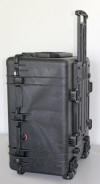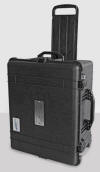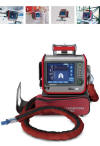One Ventilator for Everything. The HAMILTON-T1 combines for the first time the functionality of a fully featured intensive care unit ventilator with the compactness and ruggednessrequired for transport. This combination enables you to provide optimal ventilation therapy to allpatient groups during transport.












HAMILTON-T1
Ventilator Capabilities for Pandemics and or Mass Casualties
Emergency preparedness ventilators must be versatile enough to meet the ventilator demands of a mass
casualty and/or pandemic event. The AARC provides a list of requirements in Guidelines for Acquisition
of Ventilators to Meet Demands for Pandemic Flu and Mass Casualty Incidents1, all of which the
HAMILTON-T1 either meets or exceeds.
Wide range of patient populations and ventilation therapy options.
The HAMILTON-T1 offers the same ventilation capabilities as a high-end ICU Ventilator,
and is able to provide safe, adequate ventilation for even the most severe cases of acute respiratory failure.
All state-of-the-art ventilation modes, including high flow oxygen therapy, noninvasive and invasive ventilation
modes, are available for all patient populations from a 200-gram neonate to an adult.
Capable Independence of External Power, Compressed Air and Oxygen Sources.
One integrated and one Hot-Swappable Battery provide a battery operating time of up to 9 hours.
The battery operating time can be extended as required with Additional Hot-Swappable Batteries.
The integrated high-performance Turbine enables the HAMILTON-T1 to be completely independent from
compressed air sources or a compressor, and can deliver peak flows of up to 260 l/min. Oxygen supply may be limited by events that destroy commercial infrastructure (hurricane) or hospital supplies(flood, earthquake). If necessary, the HAMILTON-T1 offers the ability to ventilate with ambient air only (21% O2).
Ease of use
Intuitive user interface
The Ventilation Cockpit on the HAMILTON-T1 consolidates the monitoring data and displays it as advanced
graphical features. These provide a quick overview of the patient’s current ventilation status and provide a
reliable basis for therapy decisions.
Quick startup settings
Quick startup settings allow you to define and store specific mode and control settings for up to three selected
patient types. Just by typing in the patient size, safe ventilation can easily be started. This may help save valuable
time in emergencies, and facilitates the use of the ventilator for staff with basic training.
All-in-one, pre-assembled breathing circuit sets
All-in-one breathing circuit sets (incl. single use circuit, expiratory valve, and flow sensor)
increase efficiency and safety, as all the neccessary consumables are supplied pre-assembled and ready to use
in one package. Additionally, the sets reduce the amount of inventory and storage space needed, and simplify the workflow.


Patient safety and lung-protection
Adaptive Support Ventilation (ASV)
The HAMILTON-T1 features the Intelligent Ventilation mode ASV. In ASV mode, the ventilator continuously
adjusts the respiratory rate, tidal volume, and inspiratory time depending on the patient‘s lung mechanics and effort.
To minimize complications from AutoPEEP and volutrauma/barotrauma, ASV automatically employs lung-protective strategies. It also prevents apnea, tachypnea, dead space ventilation, and excessively large breaths, and encourages
the patient to breathe spontaneously. This helps even staff with basic training to provide safe ventilation therapy.
Additionally, ASV assists in the safe management of common respiratory issues allowing those with
minimal experience to provide a safer level of therapy.
Optimal Alarm Detection
Even from a distance or at high noise levels, the HAMILTON-T1 alarms are easily identified by the top-mounted 360°-visible alarm lamp and the prominent alarm message on the display. Relevant alarms1 according to the
AARC include loss of power source (gas and/or electricity), low pressure, high pressure, and patient disconnection.
Single-use Consumables
All consumables are available as single-use items to help minimize the risk of infection and cross-contamination.
HEPA and NBC filters
The HAMILTON-T1 is equipped with high-grade HEPA filters to keep the interior airway free of contamination. Optionally, you can add an NBC filter adapter for attaching a standard NBC filter canister to reliably protect the patient against a wide range of harmful airborne substances.
One Ventilator for Everything
Approved for all types of transport
The HAMILTON-T1 is approved for Ground and Air Transport. It reliably accompanies your patients to any destination, either within or outside of the hospital, on the ground, at sea, and in the air.
Mobility and Versatility
The lightweight, compact design of the HAMILTON-T1 make handling of the ventilator much easier. The
water-resistant housing offers impact protection and a shock-resistant, anti-reflective display. The HAMILTON-T1 is a rugged and reliable companion, whether you need it During Transports, in Emergency Units or in the ICU.
With the HAMILTON-T1, you have one standardized ventilator platform suitable for emergencies, pandemics and disasters. It offers ease of use, Versatility and all the Critical Care Modes and options necessary to ventilate all patient populations, while simultaneously minimizing the risk of errors due to using multiple ventilator platforms.
Standardized training program
Hamilton Medical College
Hamilton Medical College is an online training platform able to train hundreds of people on the basic operation of the ventilator in short amounts of time. Additionally, comprehensive ventilator training is also provided in video form on YouTube.
Minimal Efforts for Maintenance and Storage
Convenient transport and storage solutions
The standardized transport and storage case for the HAMILTON-T1 is lightweight, robust and watertight to protect the ventilator even in harsh environments. The case includes two breathing circuits, an operator’s manual and a charging function. This allows them to be Palletized, charged in Bulk in a protected environment, and be Easily Deployed, minimizing the effort needed to maintain the fleet in a state of readiness.
Lithium-Ion Battery Shelf Life
Correctly stored and maintained, the battery shelf life is 2 to 3 years with a maximal loss in performance of about 10%. The HAMILTON-T1 has an inbuilt state-of-health evaluator to determine the functionality of the batteries and alert you when replacement is needed.
Ventilator preventive maintenance
Annual preventive maintenance is required to ensure that the ventilators are operational and in top condition when needed. The time required for preventive maintenance is approximately 45 minutes per ventilator.
Benefits of synergies from strategic collaborations
Military deployments in disaster relief
The US Army currently uses over 1,200 HAMILTON-T1s. In the case of military deployments in disaster relief where the US Army steps in to support civilian organizations, having the same ventilator in the civilian sector will help to improve cooperation, efficiency, patient safety, and resource management, and will reduce handling issues for all staff involved.
Reservoir of Trained Clinicians
The user interfaces of all Hamilton Medical ventilators are operated according to the same logic. This enables the user to switch easily from any Hamilton Medical Ventilator to the HAMILTON-T1.
There is an installed base of over 11,000 Hamilton Medical ventilators in more than 1,200 hospitals throughout the domestic US, especially in every major metropolitan area. This means a reservoir of trained clinicians, ready and able to start working with the HAMILTON-T1 immediately in the case of pandemics or mass casualties.
Additionally, Hamilton Medical, Inc. employs a large force of clinical applications specialists in the United States, which is able to support with training of untrained staff or respiratory treatment of patients in cases of national emergencies.












